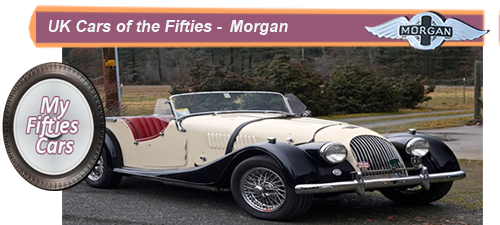
Like so many of the auto manufacturing pioneers of the early Twentieth century, Morgan Cars was founded on the talent and vision of one man, Henry Fredrick Stanley Morgan, who very quickly became known as HFS throughout the industry.
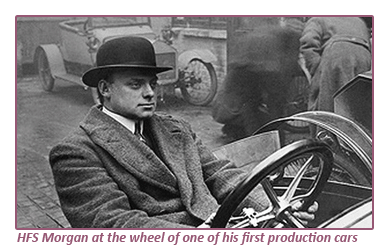 The young Morgan studied Engineering in London initially beginning his career as an apprentice at the world famous G.W.R. Railway Works at Swindon in England.
The young Morgan studied Engineering in London initially beginning his career as an apprentice at the world famous G.W.R. Railway Works at Swindon in England.
Despite being involved in the development of the steam train, still the premier means of transport in the UK during the early Twentieth century, HFS began to take an interest in the slowly emerging auto manufacturing industry.
The young Morgan gradually began to conclude that this is where his future might lie.
In 1905, with some financial backing from his family, Morgan established a small garage in the rustic village of Malvern in partnership with his close friend Leslie Bacon, who had also served his apprenticeship at G.W.R.
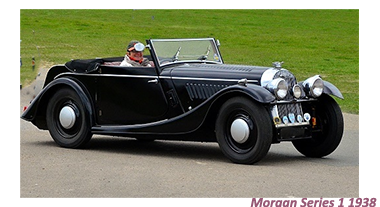 Morgan and Bacon focused their attention not only in auto service and repairs but also in selling new cars, acting as the local agents for UK manufacturers Wolseley, Siddeley and Rover as well as Automobiles Darracq S.A., of France.
Morgan and Bacon focused their attention not only in auto service and repairs but also in selling new cars, acting as the local agents for UK manufacturers Wolseley, Siddeley and Rover as well as Automobiles Darracq S.A., of France.
Although his car sales and service business at Malvern was doing excellent business, HFS Morgan was still very much an innovator at heart, was already planning to take the next step and begin to design and produce his own brand of motor cars.
In 1909, the first prototype version of a Morgan Motor Company vehicle was unveiled to a local audience in the Midlands of England. News travelled fasr about the Morgan throughout the length of the UK.
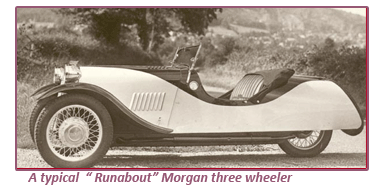 Initially presented as the Morgan Three-Wheeler, the attraction of the car was in its simplicity, yet it went on to become one of the best selling cars in the early years of the car industry in Britain.
Initially presented as the Morgan Three-Wheeler, the attraction of the car was in its simplicity, yet it went on to become one of the best selling cars in the early years of the car industry in Britain.
The commercial success of their three-wheeler allowed the Morgan Motor Company to put down solid foundations that would see them remain in business, and on their own terms, for more than a century.
The first production Morgan, known as the Runabout, was officially released at the Olympia Motorcycle Show in London in November 1910.
The reason why the Runabout made its debut at this exhibition was that it was as much a motorcycle as it was a car, and travelled on three wheels.
![]()
The following years, in response to customer feedback, Morgan continued to tweak his Runabout, first introducing a two-seater version of the Runabout as well as a hood to protect the driver and passengers from the perils of UK weather.
Most importantly, Morgan changed the drive system, adding a steering wheel, to replace the ponderous tiller that was used to steer the prototype.
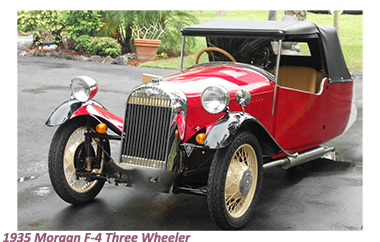 Soon after, with sales for their Runabout progressing encouragingly well, thanks to the extensive dealer network of that Morgan had established throughout the UK, HFS began his plans to increase the company's production facilities, which were stretching at the seams to keep up with demand.
Soon after, with sales for their Runabout progressing encouragingly well, thanks to the extensive dealer network of that Morgan had established throughout the UK, HFS began his plans to increase the company's production facilities, which were stretching at the seams to keep up with demand.
 The first stage in the expansion plans was the acquisition a large parcel of land, close to the existing workshops in Malvern. Construction soon got underway,
The first stage in the expansion plans was the acquisition a large parcel of land, close to the existing workshops in Malvern. Construction soon got underway,
By 1914, the Morgan Motor company was fully operational from the two massive workshops built on the new site.
More than a century later, that same Malvern site still houses the Morgan factory, with many of the production methods that HFS instituted then still being used today.
The period between the two World Wars marked a significant expansion for the Morgan Motor Company, with sales of their three-wheelers, especially during the Nineteen Twenties, continued at encouraging levels.
During the Thirties, almost inevitably, demand for three wheeler cars began to taper off as the motoring public became more interested in having four wheels on the ground.
The first production four-wheeler, the Morgan 4-4 was revealed in 1936 almost simultaneously, at the London and Paris Exhibitions of that year.
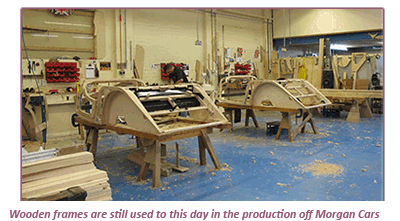 As had been conservatively predicted, the Morgan 4-4 was an overnight success. In response to customer feedback, Morgan added a four-seater version which he called the Morgan 4-4 Roadster, following that up rapidly with the release of a Drophead Coupe in 1938.
As had been conservatively predicted, the Morgan 4-4 was an overnight success. In response to customer feedback, Morgan added a four-seater version which he called the Morgan 4-4 Roadster, following that up rapidly with the release of a Drophead Coupe in 1938.
As was the case with all the UK auto manufacturers, production of road cars was put on hold throughout the Second World War, and the Morgan factory turned over their production facilities for the benefit of the war effort.
After the war, a large number of former employees who had survived unscathed returned to the Morgan plant.
One of them was Peter Morgan, HTS’s son, who took on the job of Development Engineer for the company.
![]()
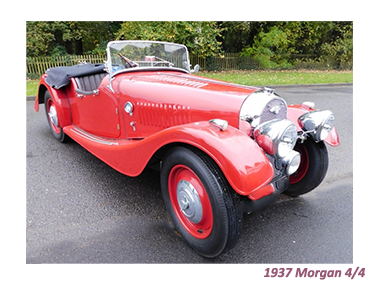 By the late Forties, demand for three-wheelers had trickled more or less to a halt, with most of the remaining production being shipped overseas to bring in valuable foreign currency, with the last Morgan three-wheeler produced leaving the factory in 1953.
By the late Forties, demand for three-wheelers had trickled more or less to a halt, with most of the remaining production being shipped overseas to bring in valuable foreign currency, with the last Morgan three-wheeler produced leaving the factory in 1953.
In the meantime, demand for Morgan four-wheel cars continued to rise, especially as they enjoyed considerable success in long-distance rallies and on the race track.
The Morgan Plus4 was available, by the early Fifties,in a choice of either open two-seater, a four-seater or Drophead Coupe format.
By 1954, Morgan had completed the revamp of their original pre-war design, with the radiator on the Plus 4 strategically placed behind a grille to improve aerodynamics.
The following year, Morgan began to fit a Triumph TR 2 engine in the car, which succeeded in generating 90 bhp.
Unbelievable though it may seem, despite some essential modifications having been instituted over the following sixty years, notably a number of engine changes, to all intents and purposes the design of the Morgan Plus4 has remained unchanged since then.
![]()
I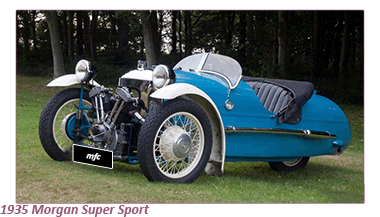 In 1955 Morgan introduced an updated version of the 4/4 which was marketed as the Series Two. The Morgan, Mark 4/4 Series Two was very similar in design and appearance to the Plus Four although fitted with a more compact 10 h.p. Side valve engine and integral gearbox provided by Ford UK.
In 1955 Morgan introduced an updated version of the 4/4 which was marketed as the Series Two. The Morgan, Mark 4/4 Series Two was very similar in design and appearance to the Plus Four although fitted with a more compact 10 h.p. Side valve engine and integral gearbox provided by Ford UK.
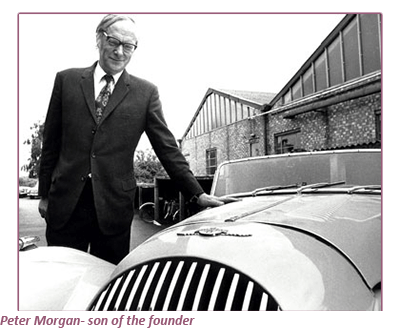 The thinking behind this development was to produce a sports car capable of providing a combination of performance and good looks and would appeal to the growing numbers of young people with money in their pockets.
The thinking behind this development was to produce a sports car capable of providing a combination of performance and good looks and would appeal to the growing numbers of young people with money in their pockets.
This market segment were in the market for a low-cost but reliable sports car.
The 4/4 Series Two fitted the bill entirely, and even more so today when it retains much the same appearance and powered by more or less the same Ford engine today.
 The Morgan car company, with Peter Morgan now in charge was moving neatly into the Sixties, as stable as ever, when the company suffered a sad loss with the passing of their renowned founder and chairman H.F.S. Morgan, at the age of 79.
The Morgan car company, with Peter Morgan now in charge was moving neatly into the Sixties, as stable as ever, when the company suffered a sad loss with the passing of their renowned founder and chairman H.F.S. Morgan, at the age of 79.
HFS, undoubtedly one of the pioneers of the UK motoring industry, led a long and fruitful life, long enough see the Morgan Motor Company achieve the success that the company deserved, seeing them remain in private family hands for the past 115 years.



